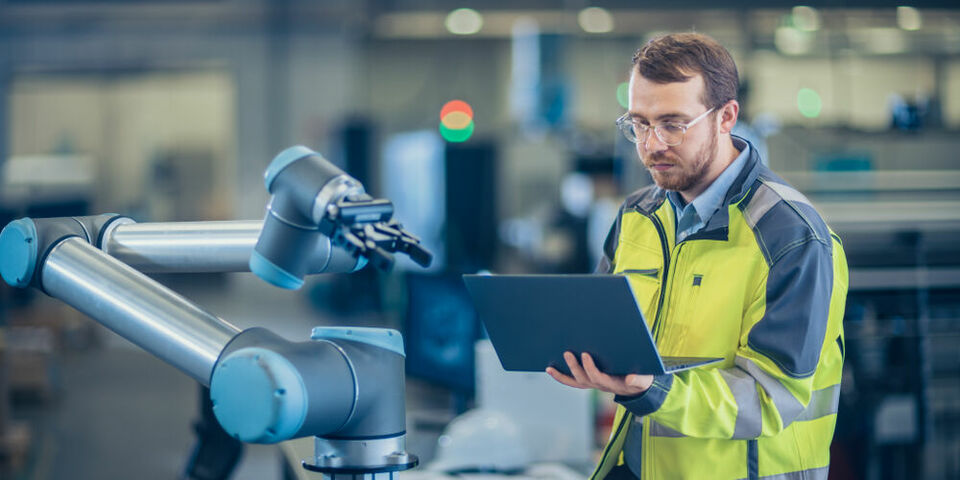“Don’t lose sight of the human factor in the manufacturing industry”
How can the European manufacturing industry remain competitive with that of China? European research program ‘Factories of the Future,’ which receives funding from Horizon 2020, tries to find an answer to that question. Paul Grefen and Irene Vanderfeesten, who worked on this comprehensive research project on behalf of TU/e, believe that small and medium-sized enterprises should stay as flexible as possible, and that it’s important not to lose sight of the human factor. Grefen recently published a book on their contribution to the program.
The ‘Factories of the Future’ program is a partnership in which European universities, knowledge institutions and companies collaborate on a wide variety of research projects. The partnership’s overall aim is to scrutinize production processes of manufacturing enterprises across Europe and to make these smarter and more efficient. Or, as Paul Grefen puts it: “Everything is aimed at Smart Manufacturing.”
Over the past few years, professor Grefen and associate professor Irene Vanderfeesten from the department of Industrial Engineering & Innovation Sciences contributed to the HORSE project, which is part of the FoF program. It ran from November 2015 until mid-2020. The project’s name refers to the deployment of modern technology to advance the manufacturing industry, just like horses were used for a similar purpose in the past.
Cheap labor force
Competing with the Chinese manufacturing industry isn’t easy for European companies, Grefen says. “Obviously, the ‘cheap labor force’ factor plays a very important role in this. Good working conditions and an honest salary are less important in China. What matters most there is bulk production of goods at the lowest possible cost. As a result, however, the implementation of changes in the production process takes a long time in China. There isn’t much flexibility yet. What’s also important is the fact that unhappy employers, because of bad or unsafe working conditions, will eventually have a negative effect on the quality of your products.”
Grefen says that the HORSE project investigated smart systems to improve the manufacturing process on the work floor. “The emphasis was on small and medium-sized enterprises, because the deployment of modern technology often proves more difficult in this sector than at large companies. Those smart systems are based predominantly on a combination of technology for the flexible control of manufacturing processes and technology for a seamless integration between humans and robots on the work floor, where safety is the top priority.”
Industrial robots
Irene Vanderfeesten says that the robots in question are stationary industrial robots and self-driving robots that can carry out industrial tasks, such as assembly line work or the transportation of goods. This is not unlike the systems used in the distribution centers of Amazon.com and Bol.com.
Vanderfeesten: “Our group specializes in the automation of these kinds of manufacturing processes. In order to guarantee both an optimal process control and the safety of workers, it’s important to constantly monitor the work floor with sensors and cameras; so-called IoT devices (Internet of Things, ed.). Humans receive their instructions from advanced interfaces – for instance via tablets, smartwatches or augmented reality devices – while the robots are controlled digitally. A system like that was applied as a prototype at ten companies across Europe, including a Dutch steel company in Maastricht. You can use robots to do the dirty and heavy work in an environment like that, but they often move much slower than humans, and there are certain tasks you would rather have carried out by human beings. It’s a matter of finding a balance.”
Grefen gives an example: “Robots have been a part of the production process in the automotive industry for years, but you can’t fully automate that process. When a company like BMW has a walnut dashboard installed in one of their luxury models, that’s done by a human. BMW doesn’t want to take the risk that a robot might accidentally leave a scratch.”
Blueprint
In order to successfully and coherently design a system like that, you need a detailed blueprint of the design, Grefen says. “We call that the architecture of the system. The architecture describes the structure of the software, of the messages, of the databases and of the underlying technology. But also of the organization and the processes that are carried out by humans and by the technology. As lead architect within the HORSE project, I was chief responsible for the architecture’s design. Irene headed TU/e’s research project within HORSE, and she’s a specialist in human factors in processes. Two doctoral candidates at TU/e worked on this project; one has obtained his doctorate by now, the other is still in the process.”
Grefen says that the book he recently published on their contribution to HORSE is intended for specialists in the manufacturing industry who apply these kinds of systems as integrators. Grefen: “Integrators are parties that combine technologies of one or several IT suppliers and integrate these with the existing automated systems at factories. But it’s also suitable for specialists at companies that produce these kinds of systems for the manufacturing industry, as well as for consultants in Smart Manufacturing and for students and scientists who are active in this field.”
The steel factory in Maastricht would have liked to consult Grefen and Vanderfeesten on the optimization of its production process. “We made it clear that this isn’t our task,” Vanderfeesten says, laughing. “We and the researchers provide the tools that a company then has to work with. The benefit is that companies will now have given this some serious thought, and that gives them an edge over their competition. This needs to become the road along which we can keep the European manufacturing industry competitive at a global level.”


Discussion